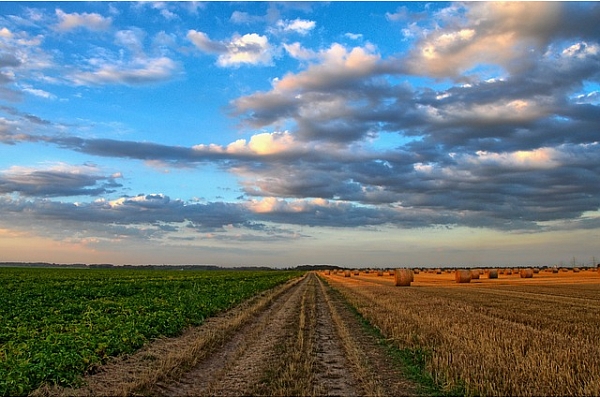Agriculture and food industry continues to raise exports
Industry in brief:
- During the first half of 2016, the value of Latvian food and agricultural exports grew 26% against the same period in 2015, making up 18.4% of the country’s total exports.
- With 12% export growth, Latvia ranks third among European Union (EU) members by export growth after Cyprus and Croatia which showed 20.3% and 14.6% export growth respectively.
- Key export products included nonalcoholic and alcoholic beverages (22% of the industry’s total export value), cereals (18%), dairy products, eggs and honey (10%).
- In the structure of food and agricultural exports, exports to the EU made up 57% and exports to third countries accounted for 43%.
- During the first half of 2016, Latvia exported products to 147 countries of the world. The value of exports to Russia, which used to be the main destination of Latvian exports, dropped 11% from the first half of 2015 to EUR 151 million. Meanwhile, the value of exports to Saudi Arabia, for example, more than doubled in the first half of 2016, totaling EUR 24 million. Latvia also exported EUR 161 million worth of products to Lithuania, EUR 108 million worth of products to Estonia, EUR 39 million worth of products to Germany, EUR 30 million worth of products to the Netherlands, EUR 29 million worth of products to Poland, EUR 8 million worth of products to Spain and EUR 2 million worth of products to France. Exports to other countries – Turkey, Kazakhstan, Ukraine, Norway, Belarus, Israel and China – were worth EUR 308 million.
Key facts about the industry
- The aggregate profit of agricultural enterprises grew from EUR 111 million in 2014 to EUR 162 million in 2015. The industry’s overall profitability rose to 5% as compared to 3% in 2014, while the number of people employed by these companies remained unchanged, at about 21,000.
- Of the industry’s 1,472 companies that generate more than EUR 145,000 in turnover, the steepest rise was recorded in the crop farming segment which grew by 75% thanks to a good grain yield. Distributors of farming equipment raised turnover by 65% and fish farmers by 56%. Livestock farmers saw their turnover contract by 44% amid dropping milk and pork prices.
- The industry paid EUR 147.309 million in taxes, of which distributors of farming equipment provided EUR 51.611 million, crop farmers EUR 50.464 million, livestock and poultry farmers EUR 41.760 million and fish farming and fishing companies EUR 3.473 million.
- Successful absorption of EU funding, which reaches EUR 1.532 billion under the Rural Development Program 2014-2020, has been defined as the greatest challenge in 2017.
Staying in all newfound export markets has not been easy
Although over the past couple of years since Russia imposed an import ban on agricultural and food products from EU member states Latvian producers of dairy, meat and fish products have found new export markets, expansion to these markets has been a slow and costly process, as exporters have had to complete time-consuming inspection and certification procedures. According to the Agriculture Ministry’s estimates, from January 2015 to June 2016 exports of dairy products were launched to 20 new markets, with deliveries to these countries totaling EUR 3.7 million and making up 1.6% of total dairy product exports. Sixteen of these markets remained active at the end of 2016. The best results were achieved in markets like Turkey, the United Arab Emirates, Japan, Georgia, Jordan, Kyrgyzstan and China.
Meat product exports were launched to nine new markets over the above period, with the value of these deliveries reaching EUR 1.9 million, or 1.8% of total meat and meat product exports. By the end of the first half of 2016, however, Kosovo remained the only new destination of Latvian meat product exports. At the same time, Latvian producers managed to substantially increase exports to existing markets: Belgium, the Czech Republic, France, Norway, Uzbekistan and Spain. Exporters of frozen fish launched exports to ten new markets, shipping EUR 0.26 million worth of products to these countries, which made up 0.2% of total export value, but in this segment, too, only one new market – Serbia – remains this year. Export volumes have been increased to two already existing markets – Portugal and Georgia.
In the segment of canned fish, exports have been launched to 11 new markets over the past year and a half, including to China, Egypt, Hong Kong, Macao, Mexico, New Zealand, Somalia, etc. with the total value of these exports reaching EUR 0.4 million, or 0.3% of total exports. Of these markets, only four still remain active – China, Egypt, Hong Kong and Somalia, and exports have also been launched to new destinations like Panama, Papua New Guinea and Iraq.
In 2016, the issue of 23 certificates were arranged, including for dairy product exports to Iraq, Mexico and the United Arab Emirates, for fisheries products going to Montenegro and for meat and meat product exports to the United Arab Emirates, Kosovo and Australia.
The ministry came to the conclusion that to enable food producers to gain foothold in new markets and reinforce their positions in their already existing markets, it is necessary to ensure active government representation at the key food industry events, to provide adequate information in export markets, as well as to provide government support to export promotion events organized by large and food companies with strong export potential.
Not everything has been going smoothly in China
Meanwhile, China, which is frequently touted as an alternative to the lost Russian market, is not an easy market to conquer, according to industry representatives. The Chinese dairy product market, for example, is worth EUR 45 billion and growing at an annual rate of 10%. Milk and yoghurt make up at least half of this amount, while milk powder and other industrial products account for the rest. Although the Chinese market is perspective both because of its size and growing demand, it is also very specific – characterized by high diversity, with consumption habits differing depending on the region or even city, specific eating traditions and demand for very high quality products. This means that before venturing into this market, sizable investments have to be made in the exploration of this market and gathering consumer feedback. Also, Latvian exporters have to be prepared that the profile of Latvia and its products in very low in China. This, of course, makes fast expansion into this market difficult, but at the same time it is an opportunity to create the image of Latvia from scratch. For this reason, the companies’ marketing costs there are very high as they have to provide information not only about their products, but also about their country of origin and its traditions.
More active state lobby needed
Staying in the existing export markets and expanding to new ones has been defined as the greatest challenge for 2017, with government lobby expected to play an important part in this. It is also important that support programs for exporters targeted not only small and medium-sized enterprises but also large exporters as they can compete in foreign markets more successfully and ensure much higher export volumes. In 2017, it is also necessary to promote loyalty to local products with various methods. This is something that all countries are doing, because in today’s circumstances of globalization they have not very many tools to protect their domestic markets. At the same time, it is also necessary to seize the opportunities provided by globalization, for example, by making products ordered in foreign markets, as several Latvian companies have been doing already. In order to enable food companies to expand to new markets and strengthen their position in the existing ones, it is necessary to ensure an active representation of the Latvian state at key food industry events and to provide adequate information to the export markets. Despite geopolitical challenges, the agricultural and food industry generally succeeded in maintaining its position as one of Latvia’s leading export sectors in 2016, with a 20% share in Latvia’s total exports. This figure is still expected to grow by a few percent in 2017.
Useful links:
Ministry of Agriculture www.zm.gov.lv
Ministry of Economics www.em.gov.lv
Central Statistics Bureau www.csb.lv
Latvian Federation of Food Enterprises www.lpuf.lv
Agricultural Market Promotion Center www.ltvc.lv
Agricultural Data Center www.ldc.gov.lv
Rural Support Service www.lad.gov.lv
Food and Veterinary Service www.pvd.gov.lv





